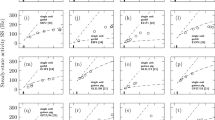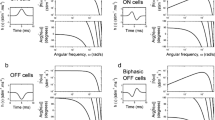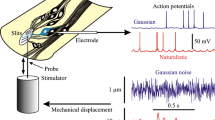Abstract
The rate coding response of a single peripheral sensory neuron in the asymptotic, near-equilibrium limit can be derived using information theory, asymptotic Bayesian statistics and a theory of complex systems. Almost no biological knowledge is required. The theoretical expression shows good agreement with spike-frequency adaptation data across different sensory modalities and animal species. The approach permits the discovery of a new neurophysiological equation and shares similarities with statistical physics.









Similar content being viewed by others
References
Norwich KH (1977) On the information received by sensory receptors. Bull Math Biol 39(4):453
Norwich KH (1993) Information, sensation, and perception. Academic Press, San Diego
Norwich KH, Wong W (1995) A universal model of single-unit sensory receptor action. Math Biosci 125(1):83
Wong W (1997) On the physics of perception. PhD thesis, University of Toronto
Benda J, Herz AV (2003) A universal model for spike-frequency adaptation. Neural Comput 15(11):2523
Drew PJ, Abbott LF (2006) Models and properties of power-law adaptation in neural systems. J Neurophysiol 96(2):826
Aviel Y, Gerstner W (2006) From spiking neurons to rate models: a cascade model as an approximation to spiking neuron models with refractoriness. Phys Rev E 73(5):051908
Famulare M, Fairhall A (2010) Feature selection in simple neurons: how coding depends on spiking dynamics. Neural Comput 22(3):581
Van der Vaart AW (2000) Asymptotic statistics. Cambridge University Press, Cambridge
Cover TM, Thomas JA (2012) Elements of information theory. Wiley, New York
Doksum KA, Bickel P (2007) Mathematical statistics: basic ideas and selected topics. Prentice Hall, Upper Saddle River
Norwich KH (1983) To perceive is to doubt: the relativity of perception. J Theor Biol 102(2):175
Kostal L, D’Onofrio G (2018) Coordinate invariance as a fundamental constraint on the form of stimulus-specific information measures. Biol Cybern 112(1–2):13
Marks L (1974) Sensory processes: the new psychophysics. Elsevier, Amsterdam
Ratliff F (1950) Involuntary motions of the eye during monocular fixation. J Exp Psychol 40(6):687
Laming D (1986) Sensory analysis. Cambridge University Press, Cambridge
Itti L, Baldi P (2009) Bayesian surprise attracts human attention. Vis Res 49(10):1295
Paul H (1982) Photon antibunching. Rev Mod Phys 54(4):1061
Adrian ED, Zotterman Y (1926) The impulses produced by sensory nerve-endings: Part 2. The response of a single end-organ. J Physiol 61(2):151
Taylor L (1961) Aggregation, variance and the mean. Nature 189:732
Kendal WS, Jørgensen B (2011) Taylor’s power law and fluctuation scaling explained by a central-limit-like convergence. Phys Rev E 83(6):066115
Jørgensen B (1997) The theory of dispersion models. Chapman & Hall, London
Kuhn A, Aertsen A, Rotter S (2004) Neuronal integration of synaptic input in the fluctuation-driven regime. J Neurosci 24(10):2345
Schwalger T, Fisch K, Benda J, Lindner B (2010) How noisy adaptation of neurons shapes interspike interval histograms and correlations. PLoS Comput Biol 6(12):e1001026
Pifferi S, Menini A (2009) The neurobiology of olfaction. CRC Press, Boca Raton, pp 203–224
Smith RL (1988) Auditory function: neurobiological bases of hearing. Wiley, Toronto, pp 243–274
Smith RL, Zwislocki J (1975) Short-term adaptation and incremental responses of single auditory-nerve fibers. Biol Cybern 17(3):169
Benda J, Longtin A, Maler L (2005) Spike-frequency adaptation separates transient communication signals from background oscillations. J Neurosci 25(9):2312
Dethier V, Bowdan E (1984) Relations between differential threshold and sugar receptor mechanisms in the blowfly. Behav Neurosci 98(5):791
Norwich KH, McConville KMV (1991) An informational approach to sensory adaptation. J Comp Physiol A 168(2):151
Schäfer S (1994) Regularity in the generation of discharge patterns by primary and secondary muscle spindle afferents, as recorded under a ramp-and-hold stretch. Exp Brain Res 102(2):198
Bohnenberger J (1981) Matched transfer characteristics of single units in a compound slit sense organ. J Comp Physiol 142(3):391
Matthews P, Stein R (1969) The sensitivity of muscle spindle afferents to small sinusoidal changes of length. J Physiol 200(3):723
Cleland B, Enroth-Cugell C (1966) Cat retinal ganglion cell responses to changing light intensities: sinusoidal modulation in the time domain. Acta Physiol Scand 68(3–4):365
Enroth-Cugell C, Robson JG (1966) The contrast sensitivity of retinal ganglion cells of the cat. J Physiol 187(3):517
Knight BW (1972) Dynamics of encoding in a population of neurons. J Gen Physiol 59(6):734
Benda J, Hennig RM (2008) Spike-frequency adaptation generates intensity invariance in a primary auditory interneuron. J Comput Neurosci 24(2):113
Wong W (2020) A universal law of sensory adaptation. BioRxiv. https://doi.org/10.1101/2020.02.17.953448
Imaizumi K, Ruthazer ES, MacLean JN, Lee CC (eds) (2018) Spontaneous activity in the sensory system. Frontiers Media, Laussane
von Holst E, Mittelstaedt H (1950) Das reafferenzprinzip. Naturwissenschaften 37(20):464
Kim SS, Sripati AP, Bensmaia SJ (2010) Predicting the timing of spikes evoked by tactile stimulation of the hand. J Neurophysiol 104(3):1484
Acknowledgements
This work was supported by a Discovery Grant from the Natural Sciences and Engineering Research Council of Canada (NSERC). The author is grateful for the many helpful discussions with Professor Kenneth Norwich, continued encouragement from Professor Manfredi Maggiore, and those who have contributed to the entropy theory in the past: Sheldon Opps, Suraya Figueiredo, Gerry Fung, Zoe Zhao, Bruno de Oliveira Floriano, Prathima Sundaram and Sai Vemula.
Author information
Authors and Affiliations
Corresponding author
Ethics declarations
Conflict of interest
The author declares no conflict of interest.
Additional information
Communicated by Benjamin Lindner.
Publisher's Note
Springer Nature remains neutral with regard to jurisdictional claims in published maps and institutional affiliations.
Appendices
A The optimal sample size
The optimal sample size \(m_\mathrm{eq}\) is the number of samples after which m no longer changes. Since the fluctuation scaling law posits that the variance of a signal increases with the magnitude of the signal, a choice of constant \(m_\mathrm{eq}\) implies that the estimation error in the mean will increase when intensity is increased. On the other hand, if the standard error \(\sqrt{\sigma ^2/m_\mathrm{eq}}\) is held constant, \(m_\mathrm{eq}\) must then take the form
requiring sample size to change significantly with intensity.
Between these two extremes lies a third possibility. Consider the situation where the sensory system is presented with an input of intensity \(I_1\) which is later changed to \(I_2\). Without loss of generality, assume that \(I_2>I_1\). At steady-state, the standard error of \(I_1\) is \(\text {SE}_1\). Let the initial uncertainty in \(I_2\) be \(\text {SE}_\text {2,initial}\). Increasing the number of samples will cause this error to fall. How is the steady-state error in \(I_2\) determined? Taking \(\text {SE}_\text {2}\) to be the geometric average of the standard errors, we obtain
That is, the error in estimating \(I_2\) is equal to the average of the steady-state error in \(I_1\) and the initial uncertainty in \(I_2\).
To see what effect (37) has on the optimal sample size, let \(m_2(0)\) be the initial sample size just after the change in intensity. Since m must remain continuous across the boundary we have \(m_2(0)=m_\mathrm{eq,1}\), where \(m_\mathrm{eq,1}\) is the optimal sample size for \(I_1\). This calculation assumes that steady-state is achieved prior to the change in intensity. From this, we conclude that the expression \(\sigma ^2/m_\mathrm{eq}^2\) is invariant to changes in intensity. Thus, the general relationship between optimal sample size and intensity is
where c is a constant. For simplicity, c is set to unity as it can be incorporated into \(\beta \) in (10). Equation (38) is the expression for optimal sample size used in the theory and can be tested both directly and indirectly through comparison with experimental data.
B Key assumptions of the theory
-
1.
The sensory receptor draws repeated, independent samples of the stimulus magnitude to estimate the mean.
-
2.
Samples are processed with limited resolution resulting in normally distributed error with zero mean and variance R, which is constant relative to the input.
-
3.
Firing rate is proportional to the Boltzmann–Shannon measure of uncertainty in the mean.
-
4.
The statistics of the sensory signal are governed by a Tweedie distribution.
-
5.
The signal mean \(\mu \) is a sum of the experimenter controlled intensity I plus constant additive background noise \(\delta I\).
-
6.
Sampling rate is a function of the difference between the current and optimal sample sizes.
-
7.
The optimal sample size is determined from an average of standard errors in the mean.
Rights and permissions
About this article
Cite this article
Wong, W. On the rate coding response of peripheral sensory neurons. Biol Cybern 114, 609–619 (2020). https://doi.org/10.1007/s00422-020-00848-4
Received:
Accepted:
Published:
Issue Date:
DOI: https://doi.org/10.1007/s00422-020-00848-4




